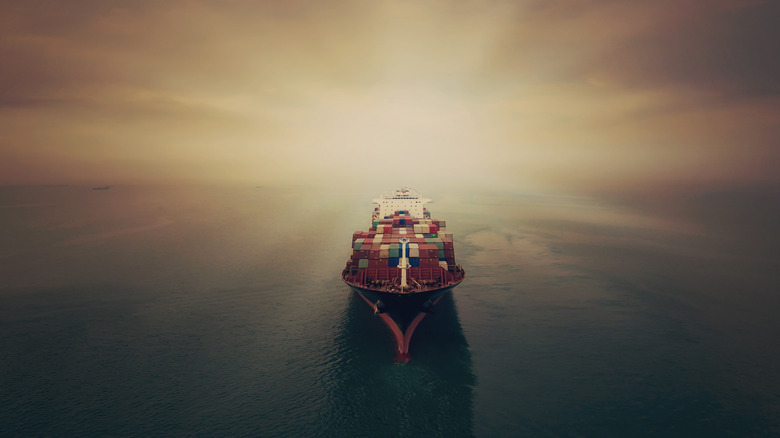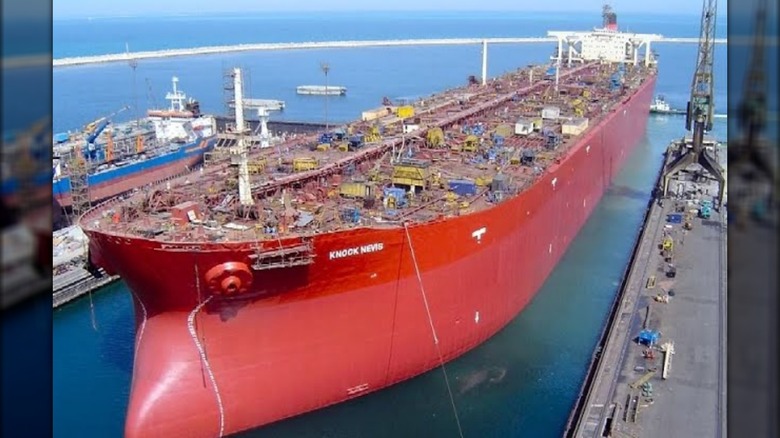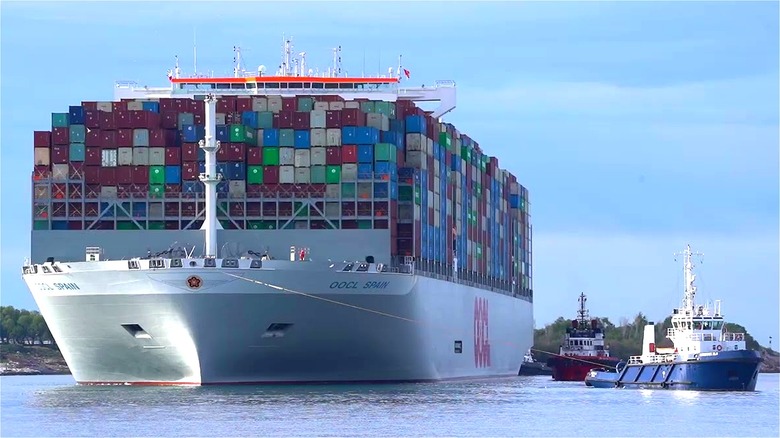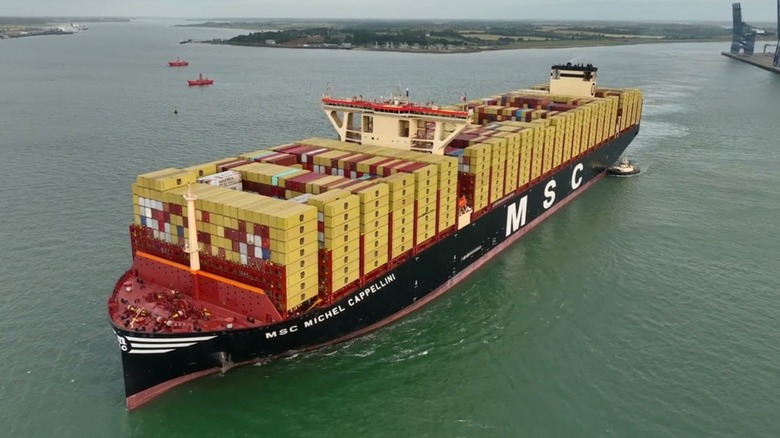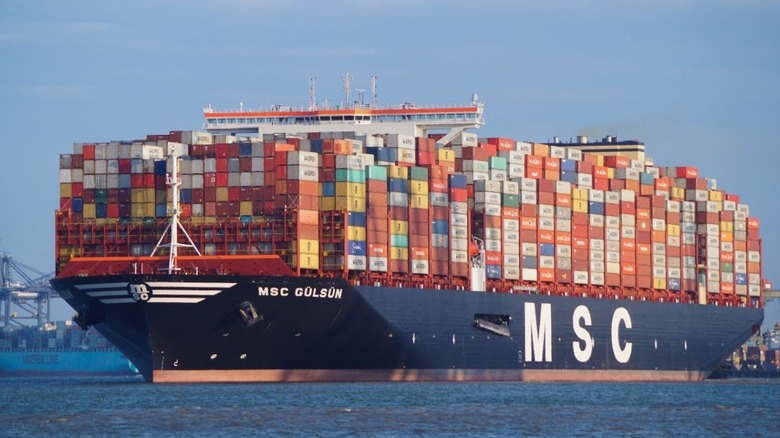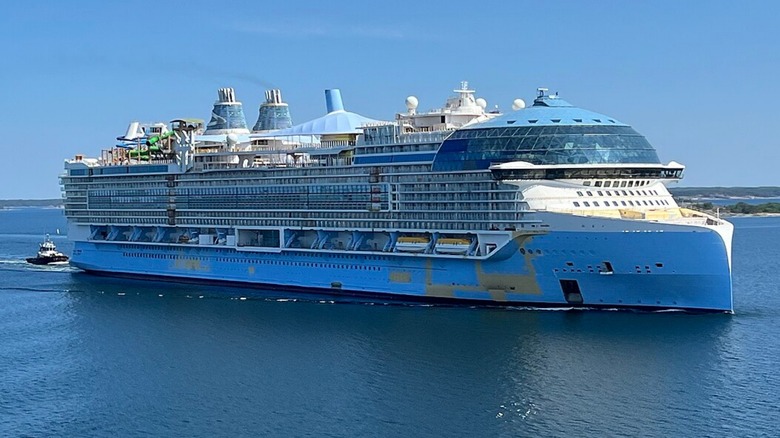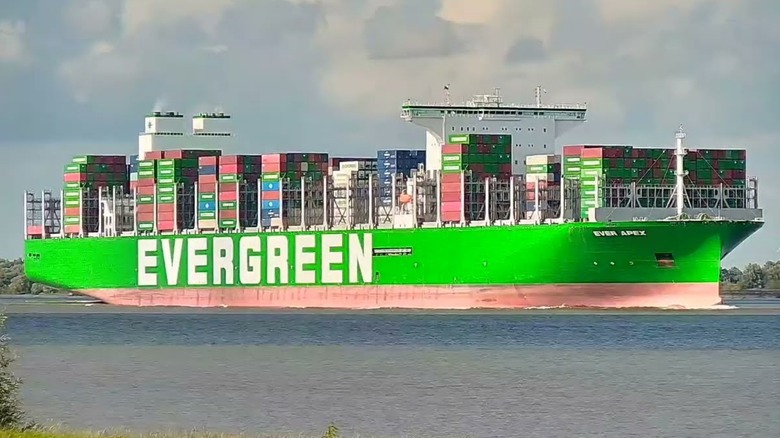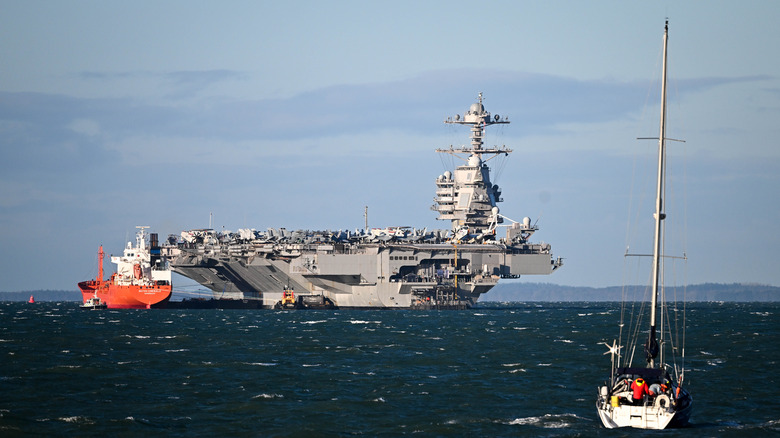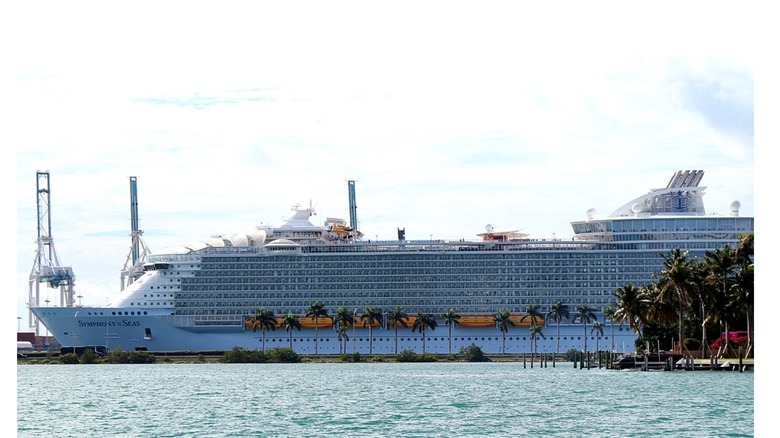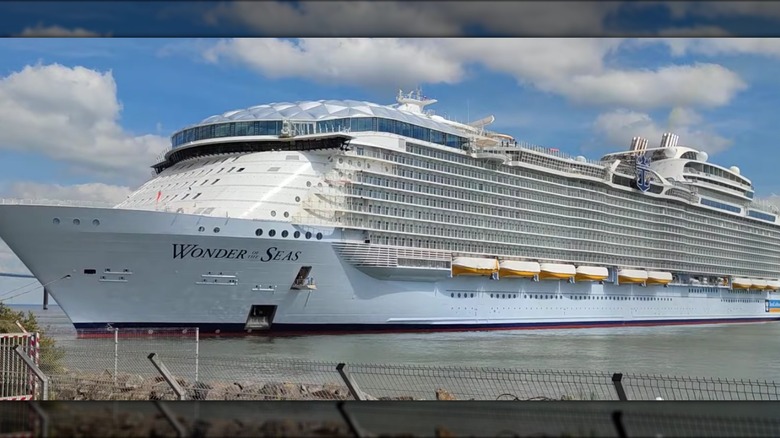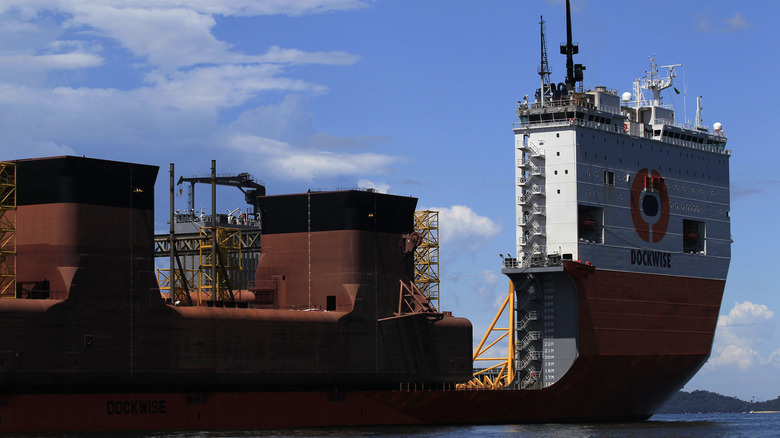10 Of The Biggest Ships The World Has Ever Seen
The ocean has long been a stage for the world's greatest engineering feats, where ever-more-colossal ships cut through the waves, each a marvel of modern technology. In looking at the world's largest ships, size and sophistication often go hand in hand, shaping the way we perceive engineering accomplishments. Every year, new and more complex ships are commissioned by companies and governments all over the world that take years to build. These vessels are becoming so large, that they're almost like cities or islands unto themselves.
Think of the Symphony of the Seas and its larger sister, the Wonder of the Seas, which have set new standards in the cruise industry with their enormous size and wide range of onboard features. There's also the MSC Gülsün, a titan of cargo transport, and the USS Gerald R. Ford, the current paragon of naval power. The Dockwise Vanguard brings a unique twist, specializing in the heavy lifting of other ships.
Each ship on this list was selected for its contribution to maritime technology, whether through size, function, or innovation. As we navigate the world of maritime giants, we'll look at some of the biggest ships the world has ever seen, focusing on ships that are not only impressive in their size but also in their impact and design, each one a remarkable example of what can be achieved in maritime engineering and design.
Seawise Giant
The tale of the Seawise Giant is nothing short of extraordinary, a saga of maritime history that's unlikely to be repeated. When it was in active service, it was 458.45 meters long and had a carrying capacity of 564,763 tons. However, when it was first built in 1979, it was several meters smaller and had about 140,000 tons less cargo hold.
The journey of the Seawise Giant begins with a twist right from the start in 1979. The original buyer backed out after commissioning it, leaving the vessel to sit in the shipyard for two years before it was eventually purchased by Orient Overseas Container Line in 1981. This is when the Seawise Giant earned its name with a "jumboization" retrofit, a process that cut the ship in half to add a new section, greatly increasing its size.
With its massive size and equally sizeable turning radius, the Seawise Giant was not an agile ship. It mainly shuttled large shipments of oil from the Middle East to the USA, capitalizing on its vast storage capacity. Unfortunately, it was attacked by Saddam Hussein's forces in 1988 and sank into the shallows.
In 1991, Normal International salvaged the wreckage of the Seawise Giant, made it seaworthy, and renamed it the Jahre Viking, allowing it to resume its duties. Despite its cargo capacity, the ship was difficult to maneuver and too large for many ports. In 2004, it became a stationary oil storage facility in Norway, until it was retired and sold for scrap in 2010.
OOCL Spain
In February 2023, OOCL (Orient Overseas Container Line Ltd) launched a groundbreaking vessel, the OOCL Spain, which became OOCL's first mega-vessel.
With a length just shy of 400 meters, the OOCL Spain can carry up to 24,188 standard shipping containers, putting it in the ranks of the world's largest shipping vessels. The OOCL was constructed in China by the Nantong COSCO KHI Ship Engineering Co., Ltd. (NACKS). Of the six massive ships that OOCL originally commissioned back in 2020, OOCL Spain was the first to hit the water and begin its duties as a shipping vessel.
Interestingly, OOCL was acquired by and falls under the umbrella of Cosco, a major player in the shipping industry globally, not to be confused with Costco, the retail giant. Though their names sound alike, they operate in completely different spheres. That said, chances are that some of Costco's goods will inevitably be transported by Cosco's services.
Cosco Shipping operates over 500 shipping vessels in over 100 countries to deliver goods worldwide. The OOCL Spain is one of the largest in the fleet, and has the distinction of being one of the few ships in the world with a carrying capacity of over 24,000 TEU (twenty-foot equivalent units or standard shipping containers), highlighting the significance of the OOCL Spain in the shipping world.
MSC Irina, MSC Loreto, and MSC Michel Cappellini
In the competitive world of shipping, shipping vessels are constantly outclassing each other in size and capacity. The title of the world's largest shipping vessel is a fleeting honor, often changing hands from year to year. The current largest capacity shipping container ship in the world goes to the MSC Irina, along with its twins: the MSC Loreto and MSC Michel Cappellini.
These extraordinary vessels have a carrying capacity of 24,346 TEU. The MSC Irina embarked on its maiden voyage on March 11th, 2023, and has already begun its service transporting goods along the Chinese coast. As some of the largest ships ever constructed, these additions to the MSC fleet significantly add to their staggering logistical potential. With the combination of these mega-ships, the MSC company can ship 22.5 million TEU every year, combined with its fleet of over 700 ships of all sizes.
The sheer scale of these ships seems to cement MSC's position as the current record holder for the largest shipping vessel in the world. In this ever-evolving industry, however, only time will tell if MSC can hold on to the record for any length of time.
MSC Gülsün
The MSC Gülsün is among the largest container ships in the world. It has a total length that's just shy of 400 meters. It has a deadweight carrying capacity of 228,149 tons and a top speed of 21 knots.
When fully loaded, the MSC Gülsün can accommodate 23,756 shipping containers, arranged in 24 rows, and includes 2,000 refrigeration slots to ensure that goods in need of temperature-controlled conditions arrive safely.
Constructed in 2019, the MSC Gülsün currently sails under the flag of Panama and spends its time transporting cargo all around the world. At the time of writing, the MSC Gülsün is currently carrying a full load of cargo from South Korea to China.
To move a vessel this size that's fully loaded with cargo, you'll need a powerful engine. The MSC Gülsün is equipped with a MAN Diesel 11G95ME-C engine. One of the largest in the world, the engine measures approximately 22 meters in length and 18 meters in height. While the engine has broken several records on its own, on the MSC Gülsün, its power has been throttled and adjusted to ensure better fuel efficiency ratios and to keep down emissions.
Icon of the Seas
Owned and operated by Royal Caribbean, the Icon of the Seas is currently the largest cruise ship in the world and a marvel of modern engineering and leisure. Construction on the gigantic vessel was completed recently in November 2023, and it went on its maiden voyage in January 2024, making a splash by breaking several world records.
On the Icon of the Seas are 20 decks, 18 of which are dedicated solely to guests and visitors. Within the ship are over 2,800 different rooms of varying sizes and a total guest capacity of 5,610, not to mention the more than 2,000 staff members who keep everything running smoothly.
Weighing in at over 250,000 tons, the ship has six liquified natural gas (LNG) engines to move its massive size from port to port. The combined engines can generate 67,500kW of thrust, giving it the energy it needs to move several hundred thousand tons.
Onboard, the ship is like a floating city with eight distinct entertainment areas. Inside the ship are eight massive entertainment "neighborhoods" with almost any amenity you can think of. There are stages for live shows, casinos, multiple pools, spas, waterparks, zip lines, and much more. It even includes six slides that have broken records for their size and design.
[Featured image by Chakie2 via Wikimedia Commons | Cropped and scaled | CC BY-SA 4.0]
Evergreen Ever Apex
In 2021, Evergreen grabbed the attention of the world when its G-Type container ship, the Ever Given, notoriously blocked the Suez Canal. This incident resulted in blocking all traffic through the shipping region and dealing a serious blow to the world's economy. It took workers a tense six days to remove the immense ship, making headlines worldwide in the process. Fortunately, the Ever Given is not the largest ship in Evergreen's fleet.
Towering above the G-Type is the A-Type, the largest class of freighter in Evergreen's fleet. The latest addition is the Evergreen Apex, launched in July of 2022. While it matches the size and cargo capacity of its A-Type siblings, essentially holding the same amount of cargo and roughly the same size, the Apex brings along a few subtle yet significant changes.
The Ever Apex is just shy of 400 meters in length and is capable of carrying approximately 225,000 tons safely across the open seas. To give you an idea, that's the equivalent of hauling the weight of 45,000 elephants or the full weight of the Willis Tower (formerly the Sears Tower). The Ever Apex is a testament to human engineering, moving through the oceans with ease, yet carrying a load that boggles the mind.
USS Gerald R. Ford
American aircraft carriers are engineering wonders. They can accommodate thousands of people, come complete with nuclear reactors, a full complement of aircraft and support vehicles, and are essentially floating cities in their own right. Whether it's for humanitarian or military missions, carriers have impressive capabilities. For many years, the Nimitz class reigned as the largest of its kind. However, in 2023, a new champion came on the scene: the USS Gerald R. Ford, the leading modern warship of its class, departing from Norfolk, Virginia.
Named after the 38th President of the United States, the USS Gerald R. Ford not only represents a new class of aircraft carriers but also marks a significant size upgrade. It measures about 333 meters in length, compared to the Nimitz class's 317 meters. While that may not seem like much of a difference, the Gerald R. Ford class was designed with advanced new weapons systems and a new electromagnetic aircraft launch system (EMALS) that allows for a greater variety of planes to be launched from its deck.
Although commissioned in 2017, the USS Gerald R. Ford is only now beginning to see active service as the world's largest aircraft carrier. It took six years of development and preparation from commissioning until its first operational mission. This class of carrier can hold over 4,500 crew members and support staff, a full wing complement (75 aircraft), and support ground vehicles, illustrating the capacity and operational versatility of the ship.
Symphony of the Seas
Nothing says luxury quite like the opulence of cruises. The Symphony of the Seas, owned and operated by Royal Caribbean, is one of the most indulgent. Not only is it one of the largest oceangoing vessels on the planet, but it's also filled to the brim with entertainment for its guests.
Launched in 2017, the Symphony of the Seas is an impressive structure that is just shy of 1,200 feet long. It has 18 decks, 24 elevators, and six total engines: three 16-cylinder Wärtsilä 16V46D and three 12-cylinder Wärtsilä 12V46D engines. Each engine is approximately the size of a shipping container and all work together to power this astonishingly large (and very fast) ship.
Onboard, there is room for 6,680 guests and a complement of 2,200 support staff and crew. The Symphony of the Seas offers 2,759 staterooms for guests and a completely separate area exclusively for the crew. What makes this even more impressive are the seven completely different "neighborhoods" onboard the Symphony of the Seas to keep guests entertained, each offering a unique experience. From luxury areas, spas, relaxing gardens, and pools to amusement parks, playgrounds, and theaters, the Symphony of the Seas looks and feels like a different world.
[Featured image by Thank You (21 Millions+) views via Wikimedia Commons | Cropped and scaled | CC BY-SA 2.0]
Wonder of the Seas
While certainly impressive, there are larger ships still than the Symphony of the Seas. In 2022, Royal Caribbean's Wonder of the Seas embarked on its maiden voyage, just barely outclassing the Symphony of the Seas in size.
The Wonder of the Seas has a guest capacity of 5,734 and a crew of 2,300. The ship is a microcosm of entertainment and luxury, divided into eight unique neighborhoods, offering a wide range of entertainment options including multiple pools, rock walls, dog parks, zip lines, bars, and restaurants. Whatever activity you're interested in, chances are, the Wonder of the Seas likely has a dedicated area for it.
When comparing the Wonder of the Seas to any other cruise ship, think of it as the embodiment of the phrase "Anything you can do, I can do better." The Wonder of the Seas is a floating luxury city filled with entertainment, but as the cruise industry grows, so too will the size of ships and vessels in their fleets. The Wonder of the Seas is a work of engineering that would be difficult to outclass, thought the Icon of the Seas is slightly longer.
[Featured image by ND44 via Wikimedia Commons | Cropped and scaled | CC BY-SA 4.0]
Dockwise Vanguard
In the world of maritime travel, huge ships sail the open seas, but even these giants can run into trouble. When the largest vessels need assistance, the job is too big for just any tugboat. That's where the Dockwise Vanguard comes in.
The Dockwise Vanguard is a semi-submersible heavy transport vessel (SSHTV), designed by Dockwise Shipyards to handle the big jobs. Think of it like a tow truck, but for moving ships as large as cruise liners. The SSHTV operates by taking on water as ballast, allowing it to sink slightly and creating a space in its docking bay. It can then maneuver a ship into its docking bay. Once secured, the ship pumps out the ballast and lifts the other ship out of the water, safely within the Dockwise Vanguard.
Though the Dockwise Vanguard may not be the largest compared to some of the other giants of the sea, it's still impressive (with a length of 270 meters), and can carry vessels that are larger than itself by having them extend past the length of the ship. It's rated at a deadweight of 110,000 tons, meaning it did not skip leg day. The sheer scope of 117,000 tons is hard to fathom (pardon the maritime pun), but the next time you see a cruise ship, know that the Dockwise Vanguard can pick it up out of the water.
